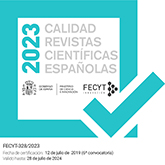Towards the digital encoding of Hispanic white mensural notation
DOI:
https://doi.org/10.3989/anuariomusical.2017.72.14Keywords:
Digital encoding, Music, Hispanic White Mensural Notation, Renaissance, Baroque, Typographical Fonts, PaleographyAbstract
In this work, the elements necessary for digitally encoding music contained in manuscripts from the centuries 16th to 17th are introduced. The solutions proposed to overcome the difficulties that generate some of the aspects that make this notation different from the modern Western notation are presented. Problems faced are, for example, the absence of bar lines or the duration of notes that are based on the context. The new typographic font “Capitán”, created specifically to represent this type of early notation, is also presented.
Downloads
References
Bellini, Pierfrancesco and Nesi, Paolo, "Automatic justification and line-breaking of music sheets", in International Journal of Human-Computer Studies, 61/1 (2004): 104-137. https://doi.org/10.1016/j.ijhcs.2003.12.001
Byrd, Donald Alvin, Music notation by computer. Doctoral dissertation, Computer Science Department, Indiana University, 1984.
Ezquerro Esteban, Antonio, "El trabajo de RISM en Espa-a", in: 18 congreso de la Asociación International de Bibliotecas Musicales, Archivos y Centros de Documentatión
Ezquerro Esteban, Antonio, Villancicos policorales aragoneses del siglo XVII. Barcelona, CSIC, 2000.
Ezquerro Esteban, Antonio (ed.), Música de la Catedral de Barcelona a la Biblioteca de Catalunya: compositors de la cort en els temps dels darrers Àustries i els primers Borbons. Barcelona, Biblioteca de Catalunya, 2009.
González Marín, Luis Antonio, Joseph Ruiz Samaniego (fl. 1653-1670): Vísperas. Barcelona, CSIC, 1999.
González Marín, Luis Antonio, Joseph Ruiz Samaniego (fl. 1653-1670): Villancicos (de dos a dieciséis voces). Barcelona, CSIC, 2001.
Mohri, Mehryar, Weighted Finite-State Transducer Algorithms. An Overview. Berlin-Heidelberg, Springer Verlag, 2004.
Pascual Hernández, Beatriz. Tipografía musical "Solera". PhD thesis. Degree project. Alicante, Escola d'Art i Superior de Disseny d'Alacant, 2014.
Pugin, Laurent, "Editing Renaissance Music: The Aruspix Project", in: Beihefte zur Editio, Internationales Jahrbuch für Editionswissenschaften. Tübingen, Max Niemeyer, 2009: 94-103.
Pugin, Laurent, Zitellini, Rodolfo and Roland, Perry, "Verovio - A library for Engraving MEI Music Notation into SVG", in: Proceedings of the 15th International Society for Music Information Retrieval Conference (ISMIR). Taipei, Taiwan, 2014: 107-112.
Renz, Kai, Algorithms and Data Structures for a Music Notation System based on GUIDO Music Notation. Phil. Diss. Darmstadt, Fachbereich Informatik, Technische Universität Darmstadt, 2002: 1-163.
Rubio, Samuel, La polifonía clásica. San Lorenzo de El Escorial, Real Monasterio de El Escorial, Biblioteca "La ciudad de Dios", 1956.
Stinson, John and Stoessel, Jason, "Encoding medieval music notation for research", in: Early Music, 42/4 (2014): 613-617. https://doi.org/10.1093/em/cau093
Strayer, Hope R. "From Neumes to Notes: The Evolution of Music Notation", in Musical Offerings, 4/1 (2013): 1-14.
Downloads
Published
How to Cite
Issue
Section
License
Copyright (c) 2018 Consejo Superior de Investigaciones Científicas (CSIC)

This work is licensed under a Creative Commons Attribution 4.0 International License.
© CSIC. Manuscripts published in both the printed and online versions of this Journal are the property of Consejo Superior de Investigaciones Científicas, and quoting this source is a requirement for any partial or full reproduction.All contents of this electronic edition, except where otherwise noted, are distributed under a “Creative Commons Attribution 4.0 International” (CC BY 4.0) License. You may read here the basic information and the legal text of the license. The indication of the CC BY 4.0 License must be expressly stated in this way when necessary.
Self-archiving in repositories, personal webpages or similar, of any version other than the published by the Editor, is not allowed.















